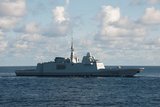Lockheed Martin AMF JTRS team delivers Joint Tactical Radio
High-capacity, secure battlefield communications links between all elements of the US military forces are one step closer to truly being connected. The Lockheed Martin team has delivered a Small Airborne Joint Tactical Radio Engineering Development Model (EDM) to the C-130J and C-5 System Integration Laboratories in Marietta, Georgia. This is the second EDM delivered to the US Air Force to support platform integration activities of the Airborne & Maritime/Fixed Station Joint Tactical Radio System (AMF JTRS).
AMF JTRS will link Airmen and Sailors with Soldiers on the ground, enabling secure (NSA Type 1) voice and data communications across diverse military units, and also providing compatibility with legacy equipment already in the force.
"This is yet another successful milestone as we move to link Air Force, Army and Navy communications," said Mark Norris, vice president for Joint Tactical Network Solutions with Lockheed Martin's IS&GS-Defense. "This delivery of an official EDM Joint Tactical Radio hosting Link-16, coupled with the earlier delivery to the US Air Force of a pre EDM supports platform integration risk reduction efforts for both C-130J and C-5 and further demonstrates the ability of a software defined radio to meet the evolving communications needs of our warfighters."
The EDM delivered to the C-130J lab is integrated with Link-16 Waveform functionality and will be used to support integration and architecture validation activities, within the Air Force Research Laboratory (AFRL) Mobility Air Forces Airborne Networking Installation & Integration program. It also provides the US. Air Force the opportunity to perform numerous networking, avionics and software checks prior to integration. Nine C-130 models, including C-130J, C-130 AMP, AC-130U, HC-130 and MC-130, are projected to incorporate AMF JTRS.
The AMF JTRS network will provide an order of magnitude improvement in allowing Warfighters in disparate areas to seamlessly communicate. To validate the difference, Lockheed Martin conducted war fighting simulations using the AMF JTRS variant being developed for aircraft and warships. Compared with existing communications gear, AMF JTRS delivers a significant gain in situational awareness and speed of command. In addition, JTRS networking waveforms provide an enormous increase in transmission capacity in any given period of time for vital targeting information and intelligence. Compared with existing communications gear, AMF JTRS delivers a significant gain in situational awareness and speed of command. In addition, JTRS networking Waveforms provide an enormous increase in transmission capacity in any given period of time for vital targeting information and intelligence.
Lockheed Martin's AMF JTRS team includes BAE Systems, General Dynamics, Northrop Grumman and Raytheon.
Source: Lockheed Martin
More from Digital Battlespace
-
![Babcock nears first customer for Nomad AI translation tool]()
Babcock nears first customer for Nomad AI translation tool
Nomad can provide militaries with real-time intelligence, saving critical time on the battlefield.
-
![AUSA 2025: Israel’s Asio Technologies to supply hundreds of improved Taurus tactical systems]()
AUSA 2025: Israel’s Asio Technologies to supply hundreds of improved Taurus tactical systems
Taurus operates alongside the Israel Defense Forces’ Orion system which supports mission management across tens of thousands of manoeuvring forces, from squad leaders to battalion commanders.
-
![AUSA 2025: Kopin pushes micro-LED plans as China moves faster]()
AUSA 2025: Kopin pushes micro-LED plans as China moves faster
The plan for the new displays follows fresh investment in Kopin’s European facilities by Theon and an order for head-up displays in fielded aircraft, with funding from the US Department of Defense.
-
![AUSA 2025: Persistent Systems to complete its largest order by year’s end]()
AUSA 2025: Persistent Systems to complete its largest order by year’s end
Persistent Systems received its largest ever single order for its MPU5 devices and other systems earlier this month and has already delivered the 50 units to the US Army’s 4th Infantry Division.
-
![Aselsan brings in dozens of companies and systems under the Steel Dome umbrella]()
Aselsan brings in dozens of companies and systems under the Steel Dome umbrella
Turkey has joined the family of countries attempting to establish a multilayered air defence system with government approval in August 2024 for the effort landed by Aselsan. Dubbed Steel Dome, the programme joins Israel’s Iron Dome, the US Golden Dome, India’s Mission Sudarshan Chakra and South Korea’s low-altitude missile defence system.
-
![DSEI 2025: MARSS unveils new agnostic multidomain C4 system]()
DSEI 2025: MARSS unveils new agnostic multidomain C4 system
MARSS’ NiDAR system has been deployed using sensors from static platforms to provide detection and protection for static sights, such as critical infrastructure, ports and military bases.



























